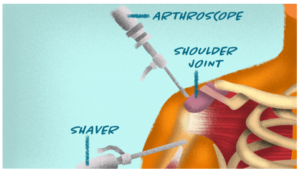Frozen Shoulder Surgery: A Comprehensive Overview
Frozen shoulder (adhesive capsulitis) is a painful condition characterized by stiffness, restricted motion, and inflammation in the shoulder joint. While many cases of frozen shoulder can be managed with conservative treatments such as physical therapy, medications, and homee remedies, some individuals may require surgery if their condition becomes severe or does not respond to non-surgical treatments. Below, we will discuss the types of frozen shoulder surgery, the pros and cons, recovery expectations, and when surgery may be necessary.
medications, and homee remedies, some individuals may require surgery if their condition becomes severe or does not respond to non-surgical treatments. Below, we will discuss the types of frozen shoulder surgery, the pros and cons, recovery expectations, and when surgery may be necessary.
Do You Need Surgery for Frozen Shoulder?
Most people with frozen shoulder can recover with non-surgical treatments, including stretching exercises, physical therapy, and pain relief medications. However, in more severe cases or when the condition does not improve with conservative care, surgery may be required to restore range of motion and relieve pain.
When Surgery Is Needed
- Severe Stiffness: If physical therapy and other treatments have not been effective in restoring shoulder movement.
- Persistent Pain: If pain persists for an extended period, hindering daily activities, despite trying medications and other methods.
- Failure to Improve: If conservative methods such as steroid injections or shockwave therapy have not brought improvement.
Types of Frozen Shoulder Surgery
There are two main types of surgical interventions for frozen shoulder:
- Shoulder Manipulation Surgery
Manipulation under anesthesia is a procedure where the doctor moves the shoulder while the patient is under anesthesia. This can help break up scar tissue and adhesions that are causing the stiffness in the joint. After the procedure, the patient is typically required to engage in physical therapy to maintain the range of motion.
- Pros: A quick procedure that can provide immediate improvements in shoulder mobility.
- Cons: Potential for temporary or recurrent stiffness, and the procedure might not work for all patients.
- Frozen Shoulder Release Surgery
In this procedure, the surgeon makes small incisions to release the tight capsule surrounding the shoulder joint. This procedure helps relieve the scar tissue buildup that is limiting movement.
- Pros: Long-term improvement in shoulder mobility, often offering more permanent relief compared to manipulation.
- Cons: Longer recovery time, potential complications such as infection, and need for intensive physical therapy post-surgery.
Pros and Cons of Frozen Shoulder Surgery
Like any surgery, frozen shoulder surgery has both benefits and risks:
Pros
- Restores Mobility: Surgery can restore a greater range of motion in the shoulder and improve function.
- Pain Relief: For patients who have not found relief through conservative measures, surgery can significantly reduce pain.
- Long-Term Results: While recovery may take time, many patients experience long-lasting improvements in shoulder function after surgery.
Cons
- Risk of Complications: As with any surgery, there is a risk of complications, including infection, bleeding, or nerve damage.
- Recovery Time: Surgery requires a lengthy recovery period, with many patients needing physical therapy for several months to regain full function.
- Not Always Effective: Surgery might not work for all individuals, and in some cases, stiffness can return after a period of improvement.
Frozen Shoulder Surgery Recovery and Rehabilitation
Recovery from frozen shoulder surgery generally takes several months, with the following key milestones:
- Initial Recovery (1-2 weeks): After surgery, the shoulder is usually placed in a sling to reduce movement and encourage healing. Pain management is a key focus during this period.
- Physical Therapy (3-6 months): Rehabilitation is critical for regaining shoulder mobility. Physical therapy helps restore the range of motion and strengthen the muscles surrounding the shoulder. The success of the surgery largely depends on how well the patient adheres to a post-surgery rehabilitation program.
- Return to Normal Activities (6 months): Most patients can return to normal daily activities and even resume exercise after 6 months, but full recovery may take up to a year.
Frozen Shoulder Surgery Video and Demonstrations
For individuals interested in understanding what frozen shoulder surgery entails, there are various surgery videos available online. These videos typically provide step-by-step demonstrations of frozen shoulder manipulation surgery or shoulder release surgery. Watching these videos can provide patients with a clearer understanding of what to expect during the procedure and post-surgery care.
Does Frozen Shoulder Require Surgery?
Surgery is typically considered when other treatments have failed to relieve symptoms. Frozen shoulder surgery is not usually a first-line treatment, but it can be effective in cases where the pain and stiffness are severe or persistent, and other treatments such as medications, physical therapy, and injections have not provided sufficient relief.
Curapod Can Support Recovery Post-Surgery
After frozen shoulder surgery, Curapod can play a significant role in the recovery process. Here’s how Curapod can assist:
- Pain Management: Curapod uses electrical stimulation to help manage pain by blocking pain signals and reducing inflammation. This non-invasive treatment can complement pain medications and provide relief, especially in the early stages of recovery.
- Muscle Relaxation and Improved Circulation: Post-surgery, Curapod helps relax muscles and improve blood circulation, which is crucial for healing. Increased blood flow helps deliver oxygen and nutrients to the healing tissues, speeding up recovery.
- Enhancing Physical Therapy: Curapod can be used alongside physical therapy to improve mobility and reduce muscle spasms. It can also help prepare the shoulder for rehabilitation exercises by relaxing tight muscles and enhancing circulation.
References (Cardiff Harvard Style)
- Mayo Clinic, 2025. Frozen Shoulder: Symptoms and Causes. Available at: https://www.mayoclinic.org/diseases-conditions/frozen-shoulder/diagnosis-treatment/drc-20370892 [Accessed 28 February 2025].
- American Academy of Orthopaedic Surgeons (AAOS), 2025. Frozen Shoulder: Symptoms, Causes, and Treatment. Available at: https://www.aaos.org/diseases–conditions/frozen-shoulder/ [Accessed 28 February 2025].
- Spine-Health, 2025. Frozen Shoulder Treatment and Exercises. Available at: https://www.spine-health.com/conditions/shoulder-pain/frozen-shoulder [Accessed 28 February 2025].
- Paolo Juden on April 18, 2022 Frozen Shoulder Surgery: What You Need to Know. Available at: https://shouldersavvy.com/frozen-shoulder-surgery/ [Accessed 28 February 2025].


